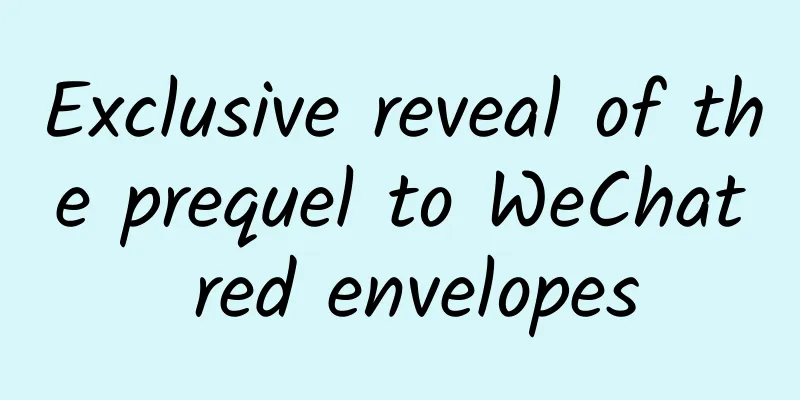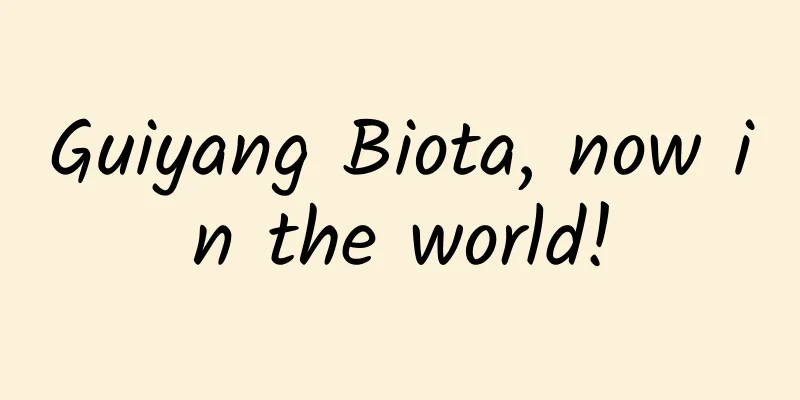Exclusive reveal of the prequel to WeChat red envelopes

|
The WeChat red envelope system code writing started on January 10. At this time, there were still 20 days before the WeChat red envelope sending reached its peak. A red envelope team of about 10 people worked day and night to build a system that would detonate the Chinese human society. Zhang Xiaolong did not participate in the specific development details of the "WeChat red envelope" product, which touched people's hearts. However, a person close to the WeChat team said that any new function of WeChat must be approved by Zhang Xiaolong before it goes online. But the WeChat red envelope product is consistent with the philosophy of WeChat founder Zhang Xiaolong. Zhang Xiaolong once said: "After working for so many years, I feel that the most important thing is to understand human nature." This is the basis for the success of WeChat red envelopes. During the nine days from the Lunar New Year's Eve to the eighth day of the first lunar month, more than 8 million Chinese people received a total of 40 million red envelopes, which were distributed across 34 provincial-level administrative units across the country. Each red envelope contained an average of 10 yuan. Based on this, it is estimated that red envelopes worth more than 400 million yuan were continuously sent and received on people's mobile phones. The number of people participating in the red envelope activity was the highest on New Year's Eve, with a total of 4.82 million people. The peak of traffic occurred around midnight. When it reached the instantaneous peak, 25,000 red envelopes were opened every minute. Not everyone likes the money and blessings sent by WeChat red envelopes. The one who is full of resentment towards WeChat red envelopes is Alibaba Chairman Jack Ma. At 10 pm on the second day of the first lunar month, he said in a group called "Jianghu Qing" that his old rival Tencent used WeChat red envelopes to launch a "Pearl Harbor attack." During this Spring Festival, the popularity of WeChat red envelopes has undoubtedly ruined Jack Ma's festive mood. Close Combat On the afternoon of January 28, the "New Year Red Envelope" icon appeared for the first time in the "My Bank Card" interface of WeChat. More than 600 million users can directly enter the WeChat red envelope page to start sending red envelopes. At around four o'clock in the afternoon of that day, the "New Year Red Envelope" icon first appeared in Guangzhou, the birthplace of WeChat. In the following four hours, it gradually spread to other major cities in China, then to second-, third-, and fourth-tier cities, and then to the whole country. During these four hours, Gong Chen and her colleagues stared at the data and user feedback displayed on the computer screen. With each opening of a city, the number of users using WeChat red envelopes and the feedback sent back by users would surge. "The process was really thrilling," Gong Chen recalled. She explained to reporters that whenever some major functions are launched, the Tenpay team will adopt this cautious "grayscale" launch method to prevent accidents. Previously, when Didi Taxi was launched, Beijing was first opened as a pilot, and then the scope was expanded to the whole country. Wu Yi, one of the founders of the WeChat red envelope system and vice president of Tencent’s Tenpay, is not an active public figure. When a media reporter told him that "it is widely rumored that WeChat red envelopes have caused the number of WeChat payment users to exceed 100 million overnight", he was stunned by the rumor and said, "It's too exaggerated." The deputy general manager, who was not yet accustomed to the media's pursuit, even pleaded with everyone to remain rational about WeChat red envelopes. Consistent with the low-key approach of the product team, Tencent CEO Ma Huateng did not do much publicity for WeChat red envelopes, but careful netizens still found clues that he supports WeChat red envelopes. On January 26, when WeChat red envelopes were still in internal testing, a screenshot circulated on the Internet showed that Ma Huateng was inviting some business owners to test the "grab red envelope" function. In this screenshot, Ma Huateng sent a random red envelope link, 50 random red envelopes, each with 20 yuan. The screenshot also showed that Sun Weiyue of Sinopec and Lou Jiangyue of Guangsha Group both received red envelopes. Luo Qiping, general manager of Hong Kong Creative Services Co., Ltd., also posted a 188 yuan red envelope that Ma Huateng sent her on WeChat on Tencent Weibo. Gong Chen, product director of the WeChat red envelope team, told Blog China that during the development process of WeChat red envelopes, the testing method was to send red envelopes to each other. Whenever there was an improvement in the product, they would invite the team leader or higher-level company leaders to the R&D team group to "send red envelopes" to test the product functions, and at the same time put real RMB into their own accounts. Initially, Gong Chen and his colleagues only regarded WeChat red envelopes as a Spring Festival occasion and did not expect that it would cause such a big discussion and even attract complaints from their competitor Jack Ma. The idea of using WeChat Pay to conduct "red envelope activities" was first born three months ago. As the product director, Gong Chen participated in the entire process of WeChat red envelope development. In August 2013, after Tenpay officially cooperated with WeChat to launch WeChat Pay, the Basic Product Center where Gong Chen worked began to continuously develop new products for WeChat Pay. Every move made by Gong Chen and her colleagues seemed like a close combat with Alipay.
Stimulate "wolf nature" The huge system was born in November 2013. During a brainstorming session at the Basic Product Center, Gong Chen and his colleagues came up with the idea of turning the company's tradition of sending red envelopes into an application during the 2014 Spring Festival to attract ordinary users and increase the number of users who enable WeChat Pay. After Tenpay was established, they have been designing electronic red envelopes for employees for five or six years. In early 2013, the administrative department of Tencent sent WeChat red envelopes of 200 yuan to each employee through WeChat. Although it was just a simple link to Tenpay, it was regarded by the outside world as important evidence that WeChat and Tenpay would be connected. Continuing the tradition of the real world, Gong Chen and her team members thought of building a system in the virtual world to "ask for red envelopes" from friends, so that red envelopes can be spread among WeChat friends. Technically, the "ask for red envelopes" function is similar to the existing AA payment function, and it is not difficult to implement. But this idea was overturned by Wu Yi, deputy general manager of Tenpay. Wu Yi was worried that users who were "asked for red envelopes" might be embarrassed: facing the sudden appearance of the red envelope seeker, whether to give or not, how much to give or not, it would be difficult to judge. If they were not very close friends, giving the wrong amount might cause misunderstanding. The "asking for red envelopes" project was shelved. It was not until early January this year that Gong Chen and his colleagues picked up the idea of WeChat red envelopes again. This time, they got inspiration from the dice game in the WeChat group. WeChat has a random dice rolling function. Rolling dice with multiple friends in a WeChat group is a simple and exciting way to play. A product manager suggested that if the dice were replaced with red envelopes, it would also arouse everyone's interest in participating in the game. After discussion, the red envelope team decided on this design of "grabbing" random red envelopes. Gong Chen and his colleagues had a hunch that allowing everyone to participate in the game by "grabbing red envelopes" would definitely "explode" out the users who were lurking in the group and create a lively atmosphere in the WeChat group. Their idea was finally recognized by Wu Yi. On January 10, Gong Chen and several product and technology colleagues started the technical development of this feature, just over two weeks before the Chinese New Year. In just over ten days, the technical staff developed the initial version of WeChat red envelopes. In order to test it, Gong Chen created a group of more than 150 people on WeChat. This is the first group of people to come into contact with the WeChat red envelope function, including employees of Tenpay, Guangyan WeChat team employees and some bank technicians. In this group, everyone's task is to play the game of sending and grabbing red envelopes, find problems, and put forward suggestions for improvement. At first, everyone was just testing each other by sending red envelopes, but gradually the test became a real carnival. Group members would use the blessing words "May so-and-so be blessed with good health" to force the senior people in the group to send out red envelopes. When this sentence was repeated dozens of times by group members, the people who were named would usually come out and send out red envelopes of real money. Almost every night, this group would fight for red envelopes until 3 a.m. WeChat red envelopes stimulate all the greed, anger, and ignorance in human nature. Wu Yi is also a member of this group. He is the manager of Tenpay and is forced to send red envelopes. He summed up the crazy state of the development team: "Grabbing red envelopes has forced everyone's 'wolf nature'." The "wolf nature" here refers to the irrepressible excitement and endless desire when people are faced with the stimulation of games and money. Since then, the name of the test group has also been changed to "WeChat Red Envelope Test Wolf Group". Full load operation The human factor contained in “grabbing red envelopes” immediately brought unimaginable popularity to the WeChat red envelope function. Before WeChat red envelopes were officially opened to the public, they had already spread among some WeChat users close to Tencent. On January 24, Gong Chen discovered that when there should have been only a few hundred test red envelopes, tens of thousands of red envelopes appeared. This made the WeChat red envelope team realize that the spread of the "grab red envelope" function was much faster than expected, and the "WeChat red envelope" trend that spread like a virus was beyond their imagination. The entire team had almost no rest as they were busy expanding the capacity of the WeChat red envelope system. They applied to Tencent and transferred in 10 times the number of servers originally designed, and rushed to modify the most detailed details of the WeChat red envelope system. It was not until before the launch on the 26th that Gong Chen asked his technical colleagues to change the name of a button on the "Send Red Envelope" interface from "Random Red Envelope" to the more attractive "Lucky Red Envelope", and changed the process of writing a blessing first and then grabbing the red envelope. "This way, grabbing red envelopes will be faster and more enjoyable." Gong Chen knows how to grasp the pain points of users. While everyone was indulging in the fun of grabbing red envelopes, the 22 members of the WeChat red envelope team spent the entire New Year's Eve in the office on the 9th and 10th floors of Tencent Building in Shenzhen. During the busiest days, the huge WeChat red envelope system supported by nearly 100 servers was running at full capacity, handling millions of users across the country. When designing this huge WeChat system, Gong Chen believed that 10 servers would be enough to support the simple functions of sending and grabbing red envelopes. However, on New Year's Eve, she could only hope that the system would not crash under the massive demand from users. Fortunately, although some users had to refresh the page repeatedly to grab the red envelopes, the crash did not occur. The viral spread of WeChat red envelopes became one of the hottest topics during the Spring Festival holiday. Liu Feng, senior public relations manager of Tenpay, told Blog China that during the Spring Festival holiday, the Chinese person who sent the most red envelopes sent nearly 2,000 red envelopes, while another Chinese person who received the most red envelopes received more than 800 red envelopes. Speaking of the difference between WeChat red envelopes and Alipay red envelopes, Liu Feng, who participated in the development of WeChat red envelopes, was proud, "We are a product based on different platforms." He believes that the popularity of WeChat red envelopes stems from the real social network accumulated on the WeChat platform. He told Blog China that WeChat red envelopes are just an attempt by Tenpay to realize O2O services. After WeChat Pay announced in November 2013 that it had 20 million bank card users, Liu Feng stressed that the team was not ready to release the latest data. It can be inferred that the direct conflict between Tenpay and Alipay will continue in the future. On February 7, 2014, the eighth day of the first lunar month was the first day back to work after the statutory holidays, many companies began to send out new year red envelopes to their employees via WeChat. Downstairs of Tencent Building on Shennan Avenue in Shenzhen, Tencent employees lined up to receive red envelopes as in previous years. The low-key Ma Huateng did not choose to send red envelopes using WeChat, but handed them out to thousands of employees in person according to tradition. Compared with technological means, the CEO obviously believes that this traditional, face-to-face method can help him establish a deeper emotional connection with his employees. |
<<: Spring Festival red envelope war: the biggest loser is the bank
>>: How did WeChat product managers and architects handle 1 billion red envelopes?
Recommend
Product Operation Analysis | How do social e-commerce platforms like Pinduoduo operate?
1. Product Introduction Product Overview Pinduodu...
Ma: Translating long-distance running into marathon means you know I have good endurance?
I am Dong Dong Meow Talking animals are so fun! T...
Where did the traffic of Viya and Xue Li go?
1.341 billion yuan is the amount of money that th...
Meizu Flyme exposed a large-scale security incident: hackers locked the phone and blackmailed users
Recently, a large number of Meizu mobile phone us...
A Guide to Image Management for Women in the Workplace
A guide to image management for women in the work...
Will not brushing teeth for a long time cause pneumonia? Periodontitis is related to so many systemic diseases...
Periodontitis is the most common oral disease, so...
Pinduoduo’s new e-commerce operation methodology!
Today, Pinduoduo released its Q4 and full-year fi...
No need to install the app, WeChat applet printing experience: I found it really useful after using it
At present, printing products are indispensable f...
Apple takes 80% of global mobile phone profits: How can the home appliance industry achieve both volume and profit?
Home appliance manufacturers all say that "y...
Alibaba and SAIC: What handshake? What peace?
The recent conflict between Alibaba and the State...
June Marketing Hotspot Calendar: Children's Day, College Entrance Examination, Father's Day
By June, the scorching summer begins. Along with ...
Why do your glasses reflect light when you take photos?
Produced by: Science Popularization China Produce...
Duan Tao Obstetrics and Gynecology Course
Duan Tao's Obstetrics and Gynecology Course R...
Faraday Future uses virtual reality to create FFZERO1 concept car
Faraday Future unveiled its first concept car at ...
Compare! Which factors that cause liver cancer have you come into contact with? How to prevent liver disease? Save!
Liver cancer is a malignant tumor that occurs in ...









